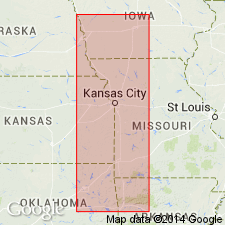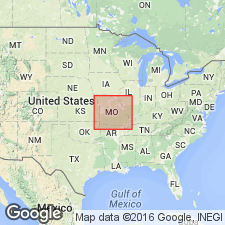
- Usage in publication:
-
- Weston shale member
- Modifications:
-
- Original reference
Summary:
Pg. 306. Weston shale. Basal member of Lawrence shales in Missouri and eastern Kansas. Underlies Iatan limestone member of Lawrence and overlies Plattsburg (Garnett) limestone. [Lawrence shale as used above is a broader unit than Lawrence shale of generally accepted usage.]
(See also "Kansas-Nebraska Pennsyvlanian correlation chart," compiled by M.G. Wilmarth, Secretary of Committee on Geologic Names, USGS, Oct. 1936.)
Source: US geologic names lexicon (USGS Bull. 896, p. 2309-2310).

- Usage in publication:
-
- Weston shale member
- Modifications:
-
- Revised
Summary:
Weston shale member --basal member of Douglas formation; underlies Iatan limestone member and overlies Stanton limestone member of Lansing formation. [This definition was followed for many years.]
Source: US geologic names lexicon (USGS Bull. 896, p. 2310).

- Usage in publication:
-
- Weston shale
- Modifications:
-
- Overview
Summary:
In 1931, (Kansas Geol. Soc. [Gdbk.], 5th Ann. Field Conf. [correlation] chart) R.C. Moore transferred Weston shale, Iatan limestone, and basal part of overlying Lawrence shale to Lansing formation, divided the rest of Lawrence shale into 3 units (to which he restricted Douglas group), and transferred Oread limestone to overlying Shawnee group. (See Kansas-Nebraska chart compiled by M.G. Wilmarth, 1936, sheet 1). In 1932 (Kansas Geol. Soc. Gdbk., 6th Ann. Field Conf.) Moore restricted Lansing group to beds below Weston shale, and assigned Weston shale, Iatan limestone, and Hardesty shale (a new name applied to basal part of Lawrence shale of previous usage) to his Pedee group (new name). This classification was followed by N.D. Newell, 1935 (Kansas Geol. Survey Bull., no. 21, p. 17, 81). Newell stated that in some areas Iatan limestone and Hardesty shale of Moore are absent and Weston is unconformably overlain by Stranger formation. [In 1938, the USGS had not yet considered these innovations for its publications.]
See also "Modern classifications of the Pennsylvanian rocks of eastern Kansas and southeastern Nebraska," compiled by M.G. Wilmarth, Secretary of Committee on Geologic Names, USGS unpub. corr. chart, Oct. 1936, 2 sheets.
Source: US geologic names lexicon (USGS Bull. 896, p. 2310).
For more information, please contact Nancy Stamm, Geologic Names Committee Secretary.
Asterisk (*) indicates published by U.S. Geological Survey authors.
"No current usage" (†) implies that a name has been abandoned or has fallen into disuse. Former usage and, if known, replacement name given in parentheses ( ).
Slash (/) indicates name conflicts with nomenclatural guidelines (CSN, 1933; ACSN, 1961, 1970; NACSN, 1983, 2005, 2021). May be explained within brackets ([ ]).

